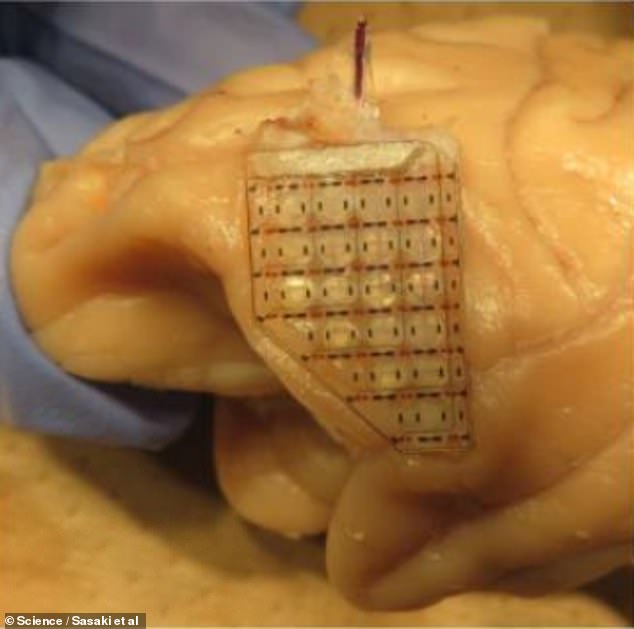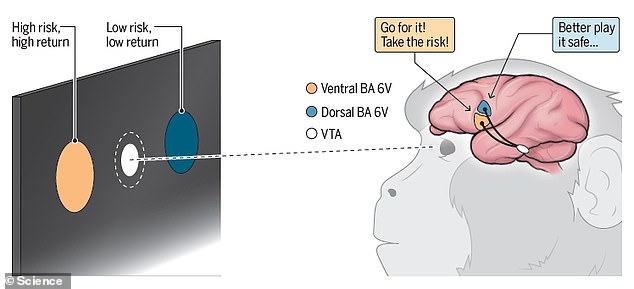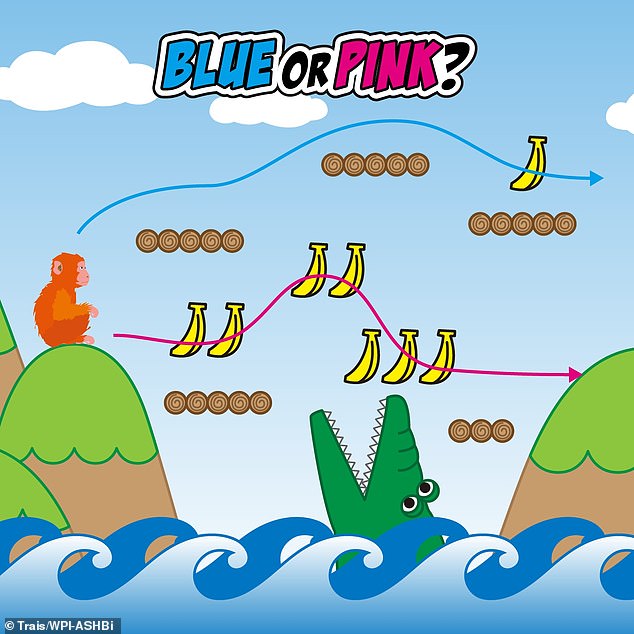The end of gambling addiction? Scientists develop a brain chip that reduces risk-taking in monkeys
Monkeys are natural risk takers, but when scientists implanted chips in their brains, they became much more cautious, according to a new study.
A team of researchers from Kyoto University in Japan used flashes of light from implanted chips to activate two different parts of the macaques' brains.
Turning on one part encouraged them to take bigger risks in the hope of a bigger payout, while turning on the other part led the animals to settle for a smaller but more certain reward.
This research provides insight into the neural roots of gambling addiction, according to the researchers behind the study.

The specially designed electrode array measures brain activity and shines a light to activate gene-edited neurons
But before digging into the brains, scientists started to find out whether their six monkeys liked to gamble.
They trained the macaques to look at different colored spots on a screen to receive a water reward.
Some places would give the monkey a small reward 90 percent of the time: low risk, low reward.
Others offered a reward ten times greater, but paid off only ten percent of the time: high risk, high reward.
Overwhelmingly, the monkeys went for the high-risk, high-reward spots. Like a gambler at a slot machine, even though they lose more often than they win, they gamble with a big payout in mind.
Next, the team tried to figure out which brain regions were in control of this risk-reward calculation.


Activating part of the monkey's frontal lobe encouraged the animal to go for a large reward that had a low probability of success. By activating a different region, the monkey stuck with an option with a better chance of winning a smaller reward


Japanese macaques, famous for lounging in mountain hot springs, are also often risk takers, scientists have found. In a video game task, they choose the high-risk, high-reward scenario almost every time
They chose several candidate areas, brain regions known to be involved in decision-making, and injected each with a chemical that stops neurons from sending signals.
When they disabled one specific region, the monkeys no longer made risky choices.
No other area had a similar effect, even areas shown to play a role in decision-making in monkeys.
The region identified by researchers is part of Brodmann's area in the monkey's frontal lobe, which has dozens of smaller parts related to all kinds of brain activities, including speech, hearing and movement.


The electrode array shines red light to activate neurons and also records their electrical activity
Specifically, it was Brodmann area 6, which is involved in planning complex and coordinated movements.
In humans, the frontal lobe is involved in personality, planning, organization, and goal-directed behavior.
The macaque's frontal lobe plays a similar role in the animal's behavior, previous research shows.
The new study, published today in the journal Sciencesupports this idea.
Scientists then tested whether they could target this brain region to switch the gambling tendency on and off.
Local gene editing in Brodmann area 6 made the neurons light-sensitive and activated in response to red light.
The team implanted a special electrode array over the altered brain area. This device not only recorded the brain's electrical activity, but also shone red lights on its surface to switch on the neurons.
They then introduced the monkeys to a new video game, one that recreated the same idea as the first, but added some new elements.
It was a simple game where monkeys took a safe path to collect a single banana, or a dangerous path to grab a whole bunch of bananas. Monkeys controlled the game by looking around the screen.
When the lower part of Brodmann area 6 was illuminated and activated, the monkeys increased risk and chose the dangerous path to a bigger reward even more often.
But when the upper part of the same region was activated, they became more cautious and chose the safer path with a smaller payout.


The video game gave monkeys a risky path to get a large reward or a safe path to get a smaller reward
“This unexpected finding implies that two adjacent regions in the frontal cortex together regulate risk attitudes in a competitive push-pull-like manner and can both increase and decrease risk seeking,” wrote Veit Stuphorn, associate professor of neuroscience at Johns Hopkins University , in an accompanying commentary.
“This is important because it opens the possibility of identifying the neuronal mechanisms in the circuit underlying this ability,” added Stuphorn, who was not involved in the new work.
Dopamine, the chemical messenger we associate with reward and positive feelings, also appears to play a role in balancing risk and reward, the researchers found.
The neurons extending from Brodmann's area carry dopamine to the ventral tegmental area, an area that has been linked to addictive behavior in humans.
Furthermore, cell staining of the monkey's brains revealed that most of the neurons that became light-sensitive were dopamine-producing neurons.
Taken together, the results led researchers to speculate that the two parts of Brodmann area 6 “might separately encode different risk-reward calculations.”
In other words, different parts of the same brain region may work in completely different ways many times a day to calculate risk.
Future research is needed to determine if this experiment targets the same areas as people with gambling addiction, but these results are promising.
A key link, they noted, is the dopamine-boosting drug pramipexole for Parkinson's disease, which has been shown to promote gambling disorders.
Because of this connection, they wrote, “our findings not only have broad implications for answering such clinically relevant questions, but also provide opportunities to better understand the underlying neural mechanism of gambling disorders in humans.”
